Shrink Film Market Research, 2031
The global shrink film market size was valued at $4.7 billion in 2021, and shrink film industry is projected to reach $8.0 billion by 2031, growing at a CAGR of 5.4% from 2022 to 2031.
Shrink film is a versatile polymer material used for the packaging of finished goods. Heat is applied to the film – by either a conveyor heat tunnel or an electric or gas heat gun – which catalyzes the film to shrink tightly around the item placed within. Most of the raw materials used to produce shrink films are mostly fossil fuels or petroleum byproducts.
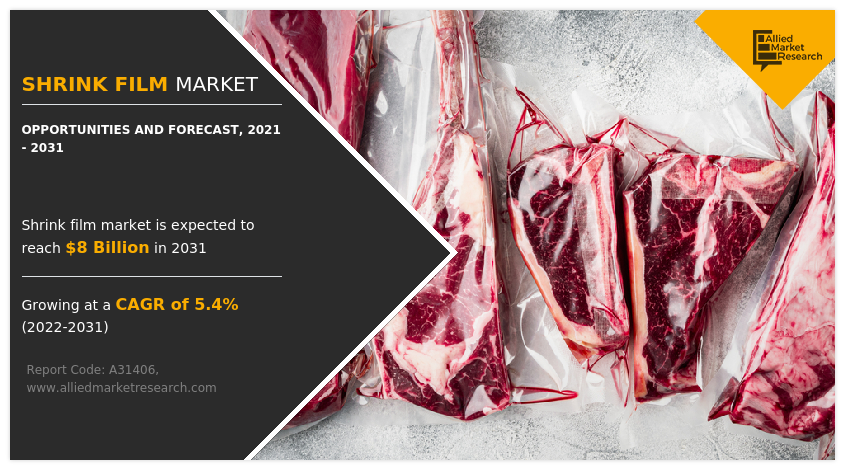
High density polyethylene (HDPE) is one of the most common polymers in plastics packaging. USDA/FDA-approved HDPE for its use for food packaging as it possesses various properties such as lightweight, durability and others. In addition, it is used for packaging water-resistant, and bad O2-resistance food products to increase the lifespan of the food products. The presence of water-resistant products in the healthcare and pharmaceutical industries and use of HDPE films in food packaging is projected to drive the application of HDPE films during the forecast period. Low density polyethylene shrink films have various properties such as low melting point, good stretch & strength; hence, it is commonly used for food and meat products and stretch wrapping/palletizing.
Among all types of polyethylene, LDPE would be the most common form which is used in shrink films. The benefits of using LDPE over the other forms of shrink packaging would be added strength and durability for heavier, larger items, like multipacks of beverages. The linear low-density polyethylene is thinner than LDPE, just as strong, decent clarity. It is primarily utilized for bulk food, frozen food, prints, grocery, trash bags, palletizing/stretch wrapping. The increase in the consumption of chilled products and transportation of expensive food materials all over the world has increased the demand for LLDPE shrink films. In addition, the increase in the delivery companies related to groceries in the developing countries and being used as a material for print in the food processing industry will have positive impact on the market.
Surge in urbanization and penetration of digitalization in most of the sectors has boosted the growth of the shrink film market. Labels are covered with shrink film materials are used in most of the marts and shopping malls to protect the information on the labels. Saudi Arabia being one of the most developed tourism country in this region have high demand for shrink films as most of the fresh products that are consumer daily are imported from other countries.
Climate changes and global warming at an alarming rate has accelerated the search for better concepts for plastic packaging. Rise in number of electronics shops in malls and super markets in retail sector is anticipated to drive the demand for consumer electronics packaging in the shrink film market during the forecast period. Increase in awareness toward social issues and rise in usage of bio-based packaging products are expected to act as a key trend in hampering the market growth in this region. The increase in the ready to eat food products demand in North America region also led to have positive impact on the market growth. In addition, the presence of highly developed technology in this region led to the presence of good healthcare and pharmaceutical manufacturing industries where shrink films are used for packing the healthcare and medicine products. The above-mentioned initiative will have positive impact over the shrink film market growth.
The shrink film market forecast is segmented on the basis of material type, thickness, packaging application, end-use and region. On the basis of material type, it is classified into polyvinyl chloride (PVC), polyolefin (POF), polyethylene (PE), and others. In material type, the polyethylene segment is further divided into High-Density Polyethylene (HDPE), Low-Density Polyethylene (LDPE), and Linear Low-Density Polyethylene (LLDPE). On the basis of thickness, the market is categorized into Less than 50 micron, 50-100 micron, 100-150 micron, and Above 150 micron. On the basis of packaging application, the market is fragmented into wraps, bags, and labels. On the basis of end-use, the market is segmented into food, beverages, healthcare and pharmaceuticals, electronics and electricals, and others. Furthermore, the food segment is further segregated into meat, poultry, and seafood, snacks, bakery and confectionary, and others.
Region wise, the market is studied across North America, Europe, Asia-Pacific, and LAMEA. Presently, Asia-Pacific accounts for the largest shrink film market share, followed by Europe and North America.
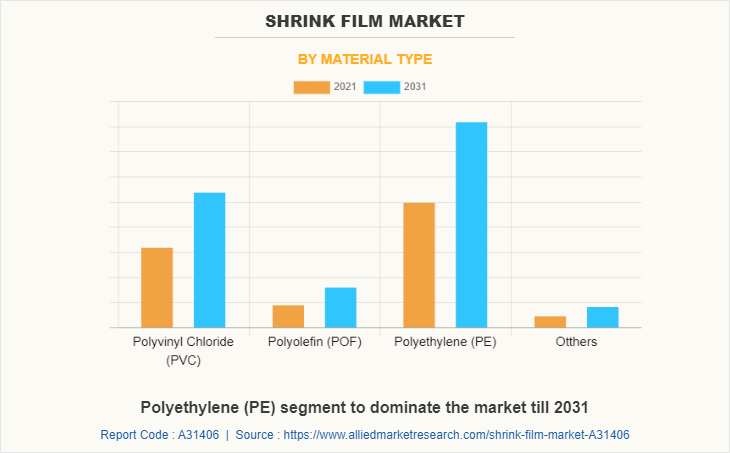
The polyethylene segment dominates the global shrink film market. Polyethylene is a type of polyolefin, meaning it is a single monomer wrap that is formed with the addition of ethylene during polymerization. PE is used in several forms of flexible protective packaging which includes shrink wrap. There are multiple forms that PE can take, but the three most common would-be Low-Density Polyethylene (LDPE), Linear Low-Density Polyethylene (LLDPE), & High-Density Polyethylene (HDPE). Each of these is best used in different industrial applications. PE is used in a shrink wrap application, it is loosely placed over a single item or multiple items and will shrink around them when heat is applied, creating a tight, tamper-resistant seal of protection. The rapid development in the manufacturing facilities of above-mentioned products will provide ample opportunities for the development of the market.
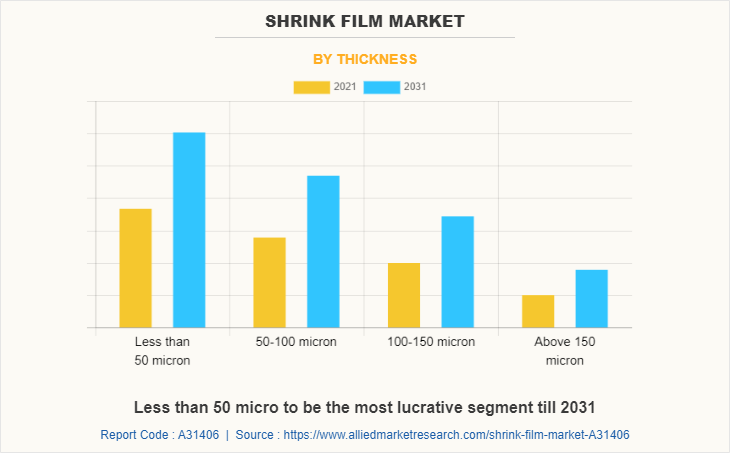
The less than 50-micron segment dominates the global Shrink film market. less than 50 micron shrink film packaging materials are used in e-commerce product delivery. It is also used to deliver fresh groceries which require relatively less thickness shrink films. It is also used in the packing of safe drinking water, and other beverage’s which are edible. The rise in e-commerce services during the pandemic have brought awareness among the people regarding the advantages of the utilization of e-commerce platform which led to increase in the investment of the major e-commerce giants to provide fresh vegetable and fruits which are consumed on daily basis. The increase in the demand for ready to eat fast food in the developed and developing countries also increased the demand for less than 50-micron plastic films which will have positive impact on the market. The above-mentioned factors will provide ample shrink film market opportunities during the forecast period.
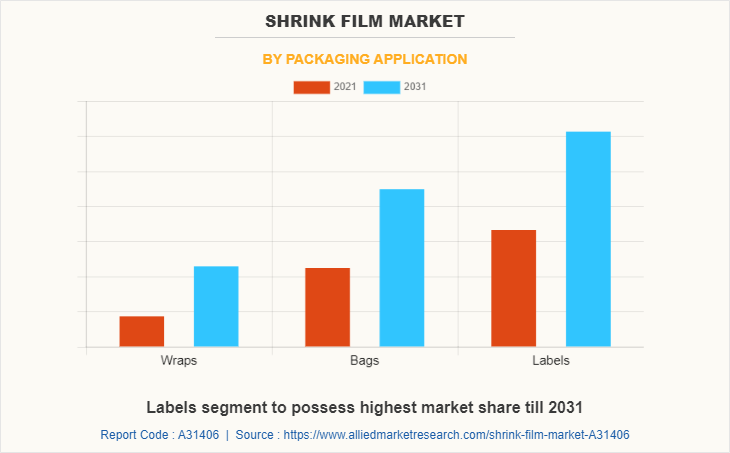
The labels segment dominates the global Shrink film market. Shrink films have ability to protect printed information on the surface of the label, hence they are used in large scale shopping malls and hypermarket malls to provide information regarding the product during billing.
Rise in shopping malls and supermarket buildings in the developed and developing countries across the globe has driven the demand for shrink film labels. These labels are widely used on the clothes and other products to provide information regarding the product. The increase in digitalization across various sector especially in the supermarket to improve the comfort and efficiency of the consumers has driven the market growth. The abovementioned factors will provide ample opportunities for the development of the market during the forecast period.
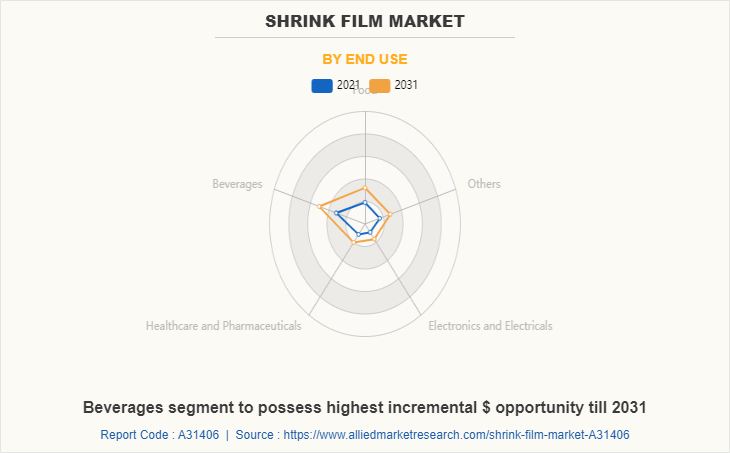
The beverage segment dominates the global Shrink film market. Beverage packaging is a substantial part of the ever-growing beverage industry. The packaging of beverages is a complex process and the diversification of beverages such as alcoholic or non-alcoholic, require different materials and containers. Proper design and adoption of a beverage package extends the shelf life of the beverage, is convenient for the users, and saves the material costs regarding wastage. The improvement in lifestyles of the population and the increase in per capita incomes mainly in the developing economies boost the consumption of packaged beverages and thereby, fuels the demand for better and convenient packaging technologies. The above-mentioned factors will provide ample opportunities for the development of the market during the forecast period.
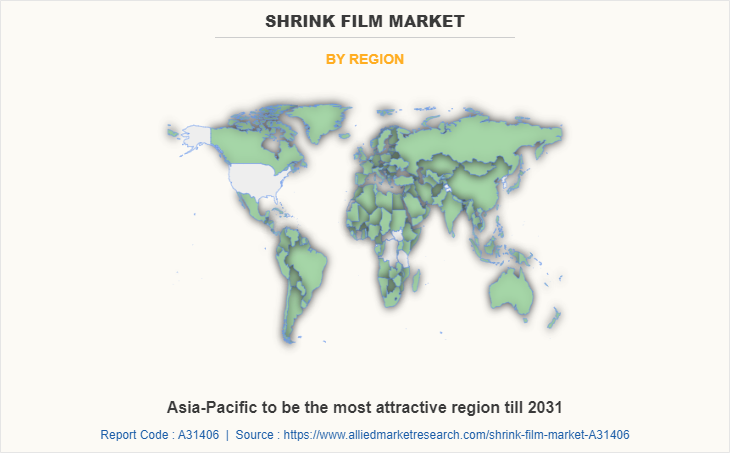
Asia-Pacific dominated the global Shrink film market. This region in a hub for manufacturing plastic related products especially in countries such as China, Japan, and India, due to low labor and low regulation over the production of these kind of products which are harmful to environment. China plays a vital role in the U.S. plastic industry. India being a high populated country has high demand for shrink film with increase in disposable income among the people. Japan where ready to eat food culture and the presence of electronic manufacturing giants in this country has led to increase in the demand for shrink films which can be used for packing food products and consumer electronics. The above-mentioned are major factors driving the growth of the market in this region during the forecast period.
Impact of Covid-19 on Global Shrink Film Market
The global COVID-19 pandemic has negative impact on the shrink film market. The outbreak of the COVID-19 pandemic in 2020 positively affected the ready-to-eat food segment due to the government restrictions and consumer apprehensions about having outside food. The pandemic has compelled consumers to focus on safety and hygiene, which has made packaged food a preferential choice over food cooked in restaurants. The lockdown restrictions severely impacted the sales of the foodervice industry, which resulted in a decline in sales of packaging materials such as shrink films.
With the ease in lockdown norms, the various industries started to produce products which are in huge demand for consumers. Food & beverage industries have started production of snacks and other food items. The increase in the demand for fast food and rise in awareness among the people regarding the importance of packaging of food materials during pandemic outbreak is also another factor which led to surge in shrink film industry.
Competitive Landscape
The major companies profiled in this report include Intertape Polymer Group Inc., Sealed Air Corporation, SYFAN USA, Clysar, Bollore Group, Kureha Corporation, Winpak Ltd., Flexopack S.A., Coveris Holdings S.A., PREMIUMPACK GmbH, Schur Flexibles Group, Kuplast Matejka Kumar S.P., Buergofol GmbH, Atlantis-Pak Co. Ltd., and Crawford Packaging. Additional growth strategies such as expansion of storage capacities, acquisition, partnership, and research & innovation in the customized packaging technologies for medical and personal care products have led to attain key developments in the global shrink film market trends.
Key Benefits For Stakeholders
- This report provides a quantitative analysis of the market segments, current trends, estimations, and dynamics of the shrink film market analysis from 2021 to 2031 to identify the prevailing shrink film market opportunities.
- The market research is offered along with information related to key drivers, restraints, and opportunities.
- Porter's five forces analysis highlights the potency of buyers and suppliers to enable stakeholders make profit-oriented business decisions and strengthen their supplier-buyer network.
- In-depth analysis of the shrink film market segmentation assists to determine the prevailing market opportunities.
- Major countries in each region are mapped according to their revenue contribution to the global market.
- Market player positioning facilitates benchmarking and provides a clear understanding of the present position of the market players.
- The report includes the analysis of the regional as well as global shrink film market trends, key players, market segments, application areas, and market growth strategies.
Shrink Film Market Report Highlights
| Aspects | Details |
| Market Size By 2031 | USD 8 billion |
| Growth Rate | CAGR of 5.4% |
| Forecast period | 2021 - 2031 |
| Report Pages | 538 |
| By Packaging Application |
|
| By End Use |
|
| By Material Type |
|
| By Thickness |
|
| By Region |
|
| Key Market Players | PREMIUMPACK GmbH, Coveris Holdings S.A., Atlantis-Pak Co. Ltd., Intertape Polymer Group Inc., Flexopack S.A., Winpak Ltd., Clysar, Crawford Packaging, Buergofol GmbH, SYFAN USA, Bollore Group, Kuplast Matejka Kumar S.P., Sealed Air Corporation, Kureha Corporation, Schur Flexibles Group |
Analyst Review
According to CXO Perspective, the global shrink film market is expected to witness increased demand during the forecast period, due to surge in the demand for personal care and pharmaceutical products among consumers.
Shrink film is made up of polymer plastic film. Plastic is covered to the product and heat is applied to covered plastic which shrinks tightly over the product it is covering. The shrink film is majorly used for the wrapping food, boxes, and bottles.
The shrink film includes polyolefin, PVC, polyethylene, polypropylene and several other compositions. Polyolefin is a preferable plastic film used for the covering and packing due to its chemical and physical properties such as availability, variety of thickness, clarities, strengths and shrink ratio over the shrink plastic film made by other materials.
The demand for shrink film is increasing from the rapidly growing food and beverages industry due to its various applicability to the industry. The inherent property of shrink plastic film to mold into various shapes and sizes for the purpose of packaging, storage, and transportation of edible items, which also boost the demand for shrink plastic film and growth of the global shrink film market.
Rise in disposable income and the presence of strong sealing capability are the key factors boosting the Shrink film market growth.
The market value of Shrink film in 2031 is expected to be $8 billion
Polymer Group Inc., Sealed Air Corporation, SYFAN USA, Clysar, Bollore Group, Kureha Corporation, Winpak Ltd., Flexopack S.A., Coveris Holdings S.A., PREMIUMPACK GmbH, Schur Flexibles Group, Kuplast Matejka Kumar S.P., Buergofol GmbH, Atlantis-Pak Co. Ltd., and Crawford Packaging.
Packaging industry is projected to increase the demand for Shrink film Market
The shrink film market is segmented on the basis of material type, thickness, packaging application, end-use and region. On the basis of material type, it is classified into polyvinyl chloride (PVC), polyolefin (POF), polyethylene (PE), and others. In material type, the polyethylene segment is further divided into High-Density Polyethylene (HDPE), Low-Density Polyethylene (LDPE), and Linear Low-Density Polyethylene (LLDPE). On the basis of thickness, the market is categorized into Less than 50 micron, 50-100 micron, 100-150 micron, and Above 150 micron. On the basis of packaging application, the market is fragmented into wraps, bags, and labels. On the basis of end-use, the market is segmented into food, beverages, healthcare and pharmaceuticals, electronics and electricals, and others. Furthermore, the food segment is further segregated into meat, poultry, and seafood, snacks, bakery and confectionary, and others. Region wise, the market is studied across North America, Europe, Asia-Pacific, and LAMEA.
Increase in consumption of packaged food & beverages is the Main Driver of Shrink film Market.
With the ease in lockdown norms, the various industries started to produce products which are in huge demand for consumers. Food & beverage industries have started production of snacks and other food items. The increase in the demand for fast food and rise in awareness among the people regarding the importance of packaging of food materials during pandemic outbreak is also another factor which led to surge in shrink film industry.
Loading Table Of Content...


